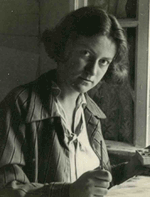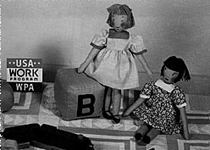Women Artists in the Government 75 Years Ago:
Four Women of the Works Progress Administration
This page profiles four inspiring women artists who worked as federal government employees as part of the Works Progress Administration seventy-five years ago: Lucienne Bloch, Hallie Flanagan, Mary Kellogg Rice, and Dorothy West.
Thousands of women artists worked for the Works Progress Administration, but there is no comprehensive list of them. Can you help us recover the stories and lessons of their lives?
Let us know if you find information about women artists who worked on WPA projects in your region so that we can share their stories with the world. You will be given a byline on our site for any stories you submit. Thanks for your help.
Lucienne Bloch, Federal Art Project

Lucienne Bloch
Lucienne Bloch was a multifaceted visual artist—photographer, muralist, sculptor—who worked for the WPA’s Federal Art Project from 1935 to 1939. This Swiss-born artist was the child of an illustrious father, the composer and photographer Ernest Bloch, and the namesake of soprano Lucienne Bréval, her godmother.
A friend and colleague of Diego Rivera and Frida Kahlo, Bloch captured the only surviving photograph of Rivera’s censored Rockefeller Center murals. She learned fresco techniques from Rivera which she first deployed in the WPA.
There is a website devoted to her work at www.luciennebloch.com, where you can see Bloch’s 1935 mural for the Women’s House of Dentention in New York City, as well as her other WPA mural projects.
Bloch and her husband, Steven Dimitroff, relocated to rural northern California in the 1960s, teaching fresco workshops and executing mural commissions, many of them on social issues, until a few years before her death in 1999.
Hallie Flanagan, Federal Theatre Project
Hallie Flanagan, born in South Dakota, raised in Iowa, was director of the Vassar Experimental Theatre when WPA head Harry Hopkins, FDR’s close advisor, picked her to head the new Federal Theatre Project in 1935. In Arena, her remarkable book about the Project (it’s still pretty easy to find used and library copies, especially of the 1975 and 1985 reprints), Flanagan articulated her vision:
“Our whole emphasis in the theatre enterprises which we are about to undertake should be on re-thinking rather than on remembering. The good old days may have been very good days indeed, but they are gone. New days are upon us and the plays that we do and the ways that we do them should be informed by our consciousness of the art and economics of 1935.”
“We live in a changing world: man is whispering through space, soaring to the stars in ships, flinging miles of steel and glass into the air. Shall the theatre continue to huddle in the confines of a painted box-set?”
“The movies, in their kaleidoscopic speed and juxtaposition of external objects and internal emotions are seeking to find visible and audible expression for the tempo and the psychology of our time. The stage too must experiment—with ideas, with the psychological relationship of men and women, with speech and rhythm forms, with dance and movement, with color and light—or it must and should become a museum product.”
“In an age of terrific implications as to wealth and poverty, as to the function of government, as to peace and war, as to the relation of the artist to all these forces, the theatre must grow up. The theatre must become conscious of the implications of the changing social order, or the changing social older will ignore, and rightly, the implications of the theatre.”
When the Federal Theatre Project—the most controversial of the five projects comprising Federal One of the WPA—was shut down in 1939, Flanagan returned to academia and taught at Smith College, a women’s college in Northampton, MA, where she remained until her retirement. Her testimony before the congressional Dies Committee (later renamed the House Committee on Un-American Activities) is featured in Tim Robbins’ 1999 film portrayal of the project, The Cradle Will Rock. Her personal archives are on file at the Smith College Library, and the main theatre space on campus is named after her.
Mary Kellogg Rice, Federal Art Project
Mary Kellogg Rice was art director of the WPA Milwaukee Handicraft Project from its creation in 1935 to 1942. When she was a senior at Milwaukee State Teachers College, her teacher Elsa Ulbricht asked her to help develop a WPA initiative for women lacking employable skills.
She assembled a team of designer-foremen, jobless art education graduates, and together, they trained women to make hand-crafted projects for children in WPA nursery schools, other local schools, hospitals, and orphanages.
Ultimately, more than a thousand women created dolls and other toys, rugs, draperies, wall hangings and upholstered furniture for Milwaukee-area institutions and public buildings. Here’s an example of her philosophy:
“It was decided that no matter how simple the article to be made or how inexpensive the materials to be used in the construction, the article would be well designed or it would not be made.”
You can find a Milwaukee WPA project cloth doll on eBay from time to time: in mid-September 2009, a quick search turned up an Italian doll (from a series in national costume) offered for $2750. Rice’s book on her project, Useful Work for Unskilled Women: A Unique Milwaukee WPA Project, was published by the Milwaukee County Historical Society in 2003 and is available on the web.
Dorothy West, Federal Writer’s Project
Dorothy West, a novelist and short story writer, was born into a prosperous Boston family, attended elite schools and excelled early. She won a Boston Post fiction contest at 14, and in 1926 at age 19, she tied with Zora Neale Hurston for second place in a writing contest sponsored by Opportunity, the National Urban League’s journal.
She was identified with the Harlem Renaissance; in 1934, she founded the journal Challenge, which published work by Margaret Walker, Richard Wright, Ralph Ellison, and other stellar figures of that movement.
After the economic failures of Challenge and its successor, New Challenge (co-created with Langston Hughes), West worked with the Federal Writers Project until its end. Half a century later, West’s work gained renewed attention when her novel The Wedding was published in 1995, and adapted by Oprah Winfrey’s production company into a made-for-TV movie in 1998, the same year she passed away.
This page was researched and written for WomenArts by Arlene Goldbard
Feel free to share the information on this page, but please be sure to credit Arlene Goldbard and WomenArts. ©WomenArts 2009.



